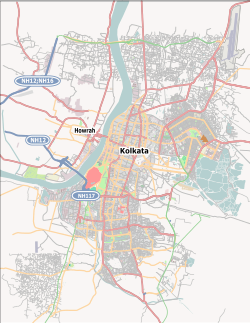Narkeldanga
Narkeldanga
Narikeldanga | |
|---|---|
Neighbourhood in Kolkata (Calcutta) | |
| Coordinates: 22°34′45″N 88°22′52″E / 22.57925°N 88.381013°E | |
| Country | |
| State | West Bengal |
| City | Kolkata |
| District | Kolkata |
| Metro Station | Phoolbagan |
| Municipal Corporation | Kolkata Municipal Corporation |
| KMC wards | 29, 30 |
| Population | |
| • Total | For population see linked KMC ward pages |
| Time zone | UTC+5:30 (IST) |
| PIN | 700011 |
| Area code | +91 33 |
| Lok Sabha constituency | Kolkata Uttar |
| Vidhan Sabha constituency | Beleghata |
Narkeldanga is a neighbourhood in North Kolkata in Kolkata district in the Indian state of West Bengal.
History
[edit]The East India Company obtained from the Mughal emperor Farrukhsiyar, in 1717, the right to rent from 38 villages surrounding their settlement. Of these 5 lay across the Hooghly in what is now Howrah district. The remaining 33 villages were on the Calcutta side. After the fall of Siraj-ud-daulah, the last independent Nawab of Bengal, it purchased these villages in 1758 from Mir Jafar and reorganised them. These villages were known en-bloc as Dihi Panchannagram and Narkeldanga was one of them. It was considered to be a suburb beyond the limits of the Maratha Ditch.[1][2][3]
Geography
[edit]Police district
[edit]Narkeldanga police station is part of the Eastern Suburban division of Kolkata Police. It is located at 6/1, Dr.M.N.Chatterjee Sarani, Kolkata-700 009.[4]
Ultadanga Women police station covers all police districts under the jurisdiction of the Eastern Suburban division i.e. Beliaghata, Entally, Maniktala, Narkeldanga, Ultadanga, Tangra and Phoolbagan.[4]
Culture
[edit]The first Indian attempt, after Gerasim Lebedev’s pioneering efforts, to stage plays in Kolkata was made at Narkeldanga. In 1832, Prasanna Kumar Tagore built a makeshift auditorium in his house in Narkeldanga and staged some English plays. The efforts were followed up by others.[5]
There is a Jewish cemetery at Narkeldanga. The first burial was in 1812. Till 1947, there was a flourishing Jewish community in Kolkata, but in 2015, only 20 were left.[6][7][8]
Transport
[edit]Narkeldanga Main Road (Maulana Abul Kalam Azad Sarani) passes through the locality. It is connected to Acharya Prafulla Chandra Road at Rajabazar and CIT Road (Hem Chandra Naskar Road) at Phoolbagan.[9]
Bus
[edit]Private Bus
[edit]- 44 Baguiati - Howrah Station
- 235 Salt Lake Karunamoyee - Amtala
Mini Bus
[edit]- S165 Phoolbagan - Howrah Station
Train
[edit]Sir Gurudas Banerjee Halt railway station on Kolkata Circular Railway line serves the locality. Sealdah Station and Bidhannagar Road railway station are also located nearby.
References
[edit]- ^ "District Census Handbook Kolkata, Census of India 2011, Series 20, Part XII A" (PDF). Pages 6-10: The History. Directorate of Census Operations, West Bengal. Retrieved 20 February 2018.
- ^ Cotton, H. E. A., Calcutta Old and New, first published 1909/reprint 1980, pp. 103-4 and 221, General Printers and Publishers Pvt. Ltd.
- ^ Nair, P. Thankappan, The Growth and Development of Old Calcutta, in Calcutta, the Living City, Vol. I, pp. 14-15, Edited by Sukanta Chaudhuri, Oxford University Press, 1995 edition.
- ^ a b "Kolkata Police". Eastern Suburban Division. KP. Retrieved 15 March 2018.
- ^ Raha, Kironmaoy, Calcutta Theatre 1835-1944, in Calcutta, the Living City, Vol I, edited by Sukanta Chaudhuri, pp 58-59, Oxford University Press, ISBN 0-19-563696-1.
- ^ "Jewish Cemetery, Narkeldanga Main Road". The Concrete Paparazzi. Retrieved 15 March 2018.
- ^ "The Last Jews of Kolkata". Aljazeera.com. Retrieved 15 March 2018.
- ^ "Recalling Jewish Calcutta". jewishcalcutta. Retrieved 15 March 2018.
- ^ Google maps
External links
[edit]![]() Kolkata/North Kolkata travel guide from Wikivoyage
Kolkata/North Kolkata travel guide from Wikivoyage


